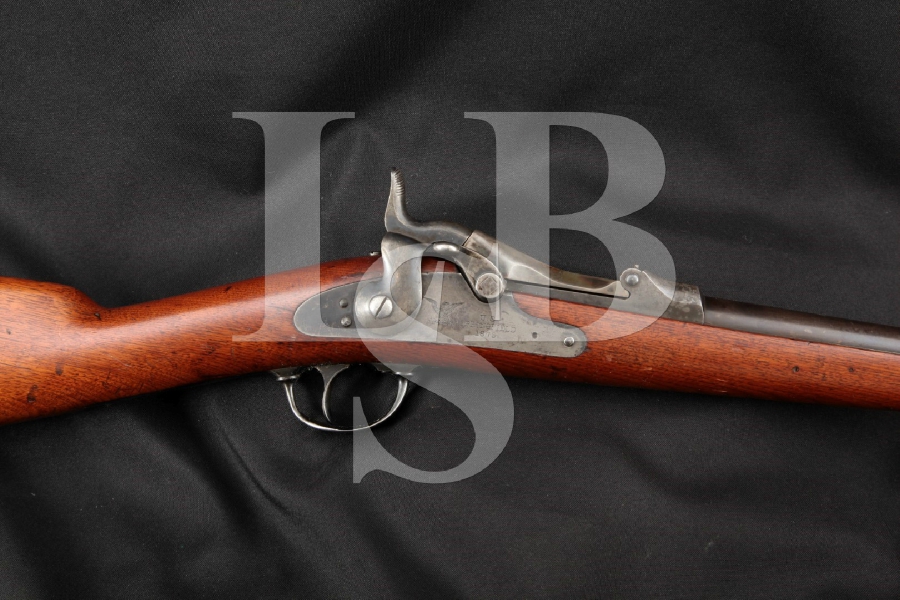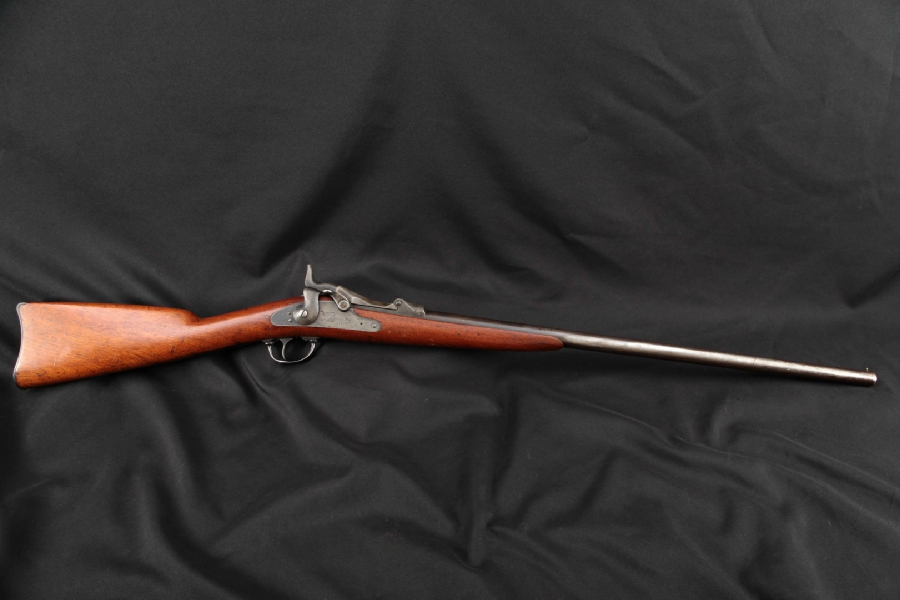
Springfield Forager Model 1881 U.S. Trapdoor Shotgun Blue/Case 26” Single Shot Shotgun, MFD 1881-1885 Antique
SOLD FOR:$2,055.00
LSB#: 160616HW02
Make: Springfield
Model: 1881 U.S. Trapdoor Shotgun nicknamed the “Forager”.
Serial Number: 590
Year of Manufacture: This rifle was made between 1881 and 1885, with a total production of 1376.
Caliber: This shotgun is chambered for 20 Gauge 2 ½” shells.
Action Type: Single Shot Trapdoor Shotgun with Ejector
Markings: The top of the breechblock is marked “1881” in slanted numerals. The right sideplate is marked with the Springfield Eagle and “U.S. / SPRINGFIELD / 1873”. The top rear of the receiver is marked “590”. There is a rectangular cartouche on the left side of the stock above the trigger and we can barely make out the scripted “SWP”, but not the date. The underside of the stock just behind the lower tang is marked “RDR” and with a circled script “P”. The “RDR” is an unknown mark and looks as though it was stamped over something else. The tang on the buttplate is marked “N / U S”.
Barrel Length: The barrel is 26” in length.
Choke: The barrel is choked Cylinder. The bore measures about 0.616” in diameter at the muzzle.
Sights / Optics: The front sight is a brass bead screwed into the barrel. The rear sight is a shallow “U” groove in the base of the breechblock and the top front of the receiver.
Stock Configuration & Condition: The stock is a one-piece walnut with a smooth straight grip and a carbine style steel buttplate. The stock has a lacquer finish. The stock is made from a Civil War musket that was cut down to about 27 5/8” total length. The ramrod groove in the forend has been filled with a slice of a walnut dowel about 3 ½” long that was shaped to match the contour of the forend. There are numerous small dings and a few shallow bruises in the forend with several dings in the buttstock section. There is a deep ding on the left side of the heel, a compression mark on the right edge of the comb and a sharp ding on the left side of the wrist. There is also a very deep ding and a hairline crack at the right side of the corner between the upper tang and the receiver. The LOP measures 13 ½” from the front of the trigger to the back of the buttplate. The buttplate shows a sharp ding at the heel, light to moderate wear and surface loss at the heel and toe, and several light marks in the remainder. The center section of the buttplate has been refinished with a dull blue finish. The buttplate is in about Good condition. The stock rates in about Very Good condition.
Type of Finish: The shotgun is blued except for the breechblock, receiver, lockplate and hammer, which are case colored.
Finish Originality: The finish is original.
Bore Condition: The bore is bright, turning gray at the muzzle. There is light erosion in the bore from the muzzle back about 1 ½”.
Overall Condition: This shotgun retains about 25% of its metal finish. There is bluing left on the barrel in the protected areas, with vivid case coloring remaining on the breechblock and receiver, with thinned bluing on the trigger guard and lower tang. Parts of the barrel have developed a mottled plum colored patina. There are numerous light handling marks and several sharp dings in the barrel including an area on the left side of the barrel at the front of the forend with multiple small dings. The lockplate shows several dings, a few scratches and a few spots of pinprick surface erosion. The trigger guard and lower tang show multiple light scratches. The screw heads are sharp but with light marks from a screw driver. The markings are clear, except for the stock cartouche, which is obscured by dings. Overall, this shotgun rates in about Very Good condition.
Mechanics: The action functions correctly. The hammer has quarter and half cock safety positions. The trigger guard is two pieces. We have not fired this shogun.
Box, Paperwork & Accessories: None.
Our Assessment: The Model 1873 “Trapdoor” Springfield was the first standard-issue breech-loading rifle adopted by the United States Army and it and the Model 1884 and 1888 Trapdoors were the main service rifles of the U.S. Military until they were gradually replaced by the Springfield Model 1892 bolt-action rifle. George Custer’s troops were armed with them at the Battle of the Little Bighorn, and they were still used by secondary units during the Spanish-American war in 1898. In 1881, a centerfire 20 gauge shotgun was built from stocks of civil War muskets and Model 1879 type receivers enlarged to take the 20 gauge brass shells used at the time. According to Flayderman’s, 1376 were made for use by government hunters and scouts at western military outposts between 1881 and 1885, with the last date of issue 1906 in Alaska. This shotgun is in about Very Good condition with about 25% of its original finish remaining. There is bluing remaining on the protected areas of the barrel, with vivid case coloring in the breechblock and receiver, and thinning on the trigger guard and lower tang. Parts of the barrel have developed a mottled plum colored patina. There are numerous light handling marks and several sharp dings in the barrel, including an area on the left side of the barrel at the front of the forend with multiple small dings. the lockplate shows several dings, a few scratches and a few spots of pinprick surface erosion. the trigger guard and lower tang show multiple light scratches. There are numerous small dings and a few shallow bruises in the forend with several dings in the buttstock section. There is a deep ding on the left side of the heel, a compression mark on the right edge of the comb and a sharp ding on the left side of the wrist. There is also a very deep ding and a hairline crack at the right side of the corner between the upper tang and the receiver. The action functions correctly. With only 1376 having been made and with its original finish, this shotgun is sure to be a big hit with the collectors. No collection of trapdoor rifles would be complete without this model, and there can’t be very many left today, with very few in as nice a condition as this one. The trapdoor and military longarms collectors are going to be fighting over this one.


